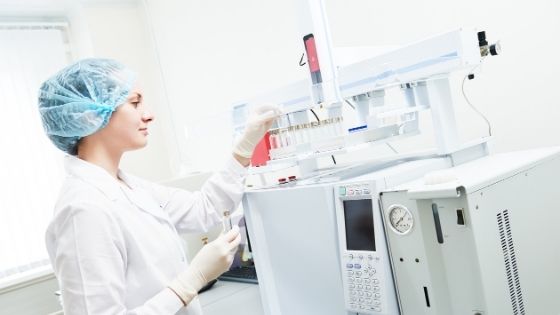Gas chromatography is a process that uses a chromatogram for separating different compounds. It is employed in analytical chemistry and vaporizes compounds instead of decomposing them. The operation comes in handy in many industries. The process involves a carrier gas such as helium that is ideal for the separation of components.
The various steps involved in the operation are identification, separation, and quantification of organic compounds. The column comprises a stationary phase and a mobile phase.
Once the compounds are released into it, they are carried forward by the carrier gas. Depending on their nature, they are divided. These compounds must have high volatility, thermal stability, low molecular weights. Gas chromatography was discovered in the early 1900s by Mikhail Semenovich Tsvett.
The most typical has chromatograms consisting of an injection port, a column, carrier gas flow control equipment, ovens and heaters for maintaining temperatures of the injection port and the column, an integrator chart recorder, and a detector.


There are two types of gas chromatography: Gas-liquid chromatography and gas-solid chromatography. Both the approaches utilize either liquid or solid as a stationary phase whilst applying gas as the mobile phase.
In Gas-solid chromatography, the preservation of analytes is credited to physical adsorption. Whereas, gas-liquid chromatography severs the atoms or molecules that are diffused in a solution.
Difference Between Gas Liquid Chromatography And Has-solid Chromatography
The most significant difference between gas chromatography and liquid chromatography is that the mobile phase of gas chromatography occurs in the presence of helium, which is a gas. The mobile phase of liquid chromatography occurs in the presence of a liquid that could be polar or nonpolar.
The stationary phase of gas chromatography is conducted with liquid silicone-based materials and uses a column. Whereas, the stationary phase of liquid chromatography uses silica and is carried in a column or plane.
Uses Of Gas Chromatography
There are many uses of gas chromatography. Some of them are listed below:
1) Food analysis: The food industry heavily depends on gas chromatography operations for various applications, including a quantitative and qualitative examination of food. The food is investigated to check for additives, zest and aroma elements, and detection and analysis of contaminants such as environmental pollutants, pesticides, fumigants, and commonly transpiring toxins.
By employing gas chromatography, the food industry can vouch for the items they sell and establish their safety. After all, these products are being consumed by several people, and a lousy analysis can be detrimental.
GC ensures reliable consumption of food products and discerning the taste, texture, and smell. People can also use other techniques, but GC continues to maintain its efficacy. It is also economical.
2) Quality control: Manufacturing products are highly contingent on GC because it establishes quality control. Companies that produce cars, chemicals, and pharmaceuticals yield from the existence of GC.
In the pharmaceuticals industry, GC aids in manufacturing more pure and refined goods. It ensures the purity of the products and eliminates any pharmaceutical inconsistencies. In this industry, GC also traces any contaminants and allows the separation of chiral compounds.
Studies manifest that the interior of new automobiles discharges volatile compounds. Using GC can discern and measure these chemical releases made by carpet, seat, pedals, linings, and seat covers. Scientists are devising new techniques to diminish the chemical release made by the interiors of new cars.
GC is also useful in producing chemicals. To make emulsifiers, solvents and co-solvents GC helps people in maintaining superior quality.
3) Research: The research domain relies on GC to analyze meteorites and natural products. Scientists examine the composition of meteorites that fall on earth utilizing GC. It gives them vital information regarding life’s nature away from earth and reveals details about primordial life on earth.
4) Forensics: The forensic department is a branch of science that also taps into GC’s goodness. It helps in determining how an individual perished. Whether it was a natural death or they were poisoned/ drugged etc. The process includes taking a blood sample and examining it using GC.
5) Estimating air pollution: Air pollution is on the rise and is one of the most pressing issues confronted by the entire world. GC is used to monitor the different harmful gases that are cluttering the atmosphere. It can also discern their nature and concentration.
Conclusion
Gas chromatography is prolific for many reasons. It entails several benefits and is cost-effective. People can derive several uses out of it, and it never fails to deliver. Gas chromatography is used throughout different industries and has been around for many years. Its relevance is the key indicator of its potency.
















